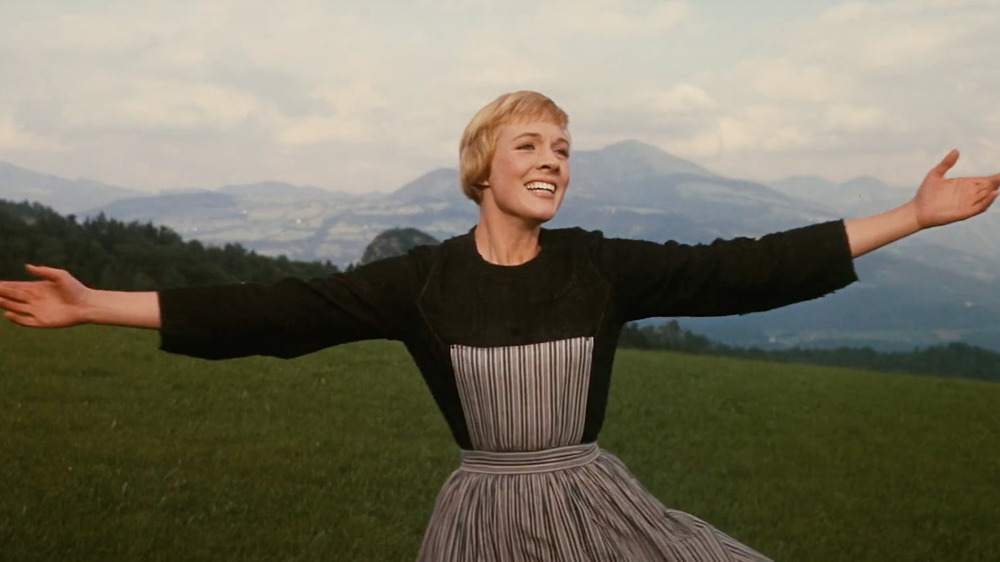
Go ahead: Say your worst about The Sound of Music. Call it sentimental, schmaltzy, mawkish, treacly. Roll your eyes with Christopher Plummer, who famously derided the material as “The Sound of Mucus.” Nod in agreement with the hostile reviews of leading critics of 1965, like Pauline Kael, who savaged the film as “the sugar-coated lie that people seem to want to eat” (but still admitted that she found herself, to her own disgust, humming the tunes).
Julie Andrews can take it—and, if you are human, you can’t say a word against her. Perhaps the best description of her presence of I’ve read is Owen Gleiberman’s tribute in his review of the 2018 legacyquel Mary Poppins Returns: Calling out her “incandescent sparkle of benevolence,” Gleiberman argues that, in just two films (Mary Poppins and The Sound of Music), Andrews “did more to turn goodness into a mythological force than any actress since Lillian Gish.”
Adapted from the last of Rodgers and Hammerstein’s collaborations, and one of their best, the film loosely reflects the real-life story of the Trapp Family Singers as related in the memoirs of Maria Augusta von Trapp, a one-time postulant at Nonnberg Abbey in Salzburg, who married a widowed naval commander, Georg von Trapp, after first teaching and looking after his children. Fleeing Austria to escape a Nazi military commission, the family came to the United States where they continued their career as a singing group.
The screen adaptation by Ernest Lehman (The King and I, West Side Story) improves on its musical source material in shrewd ways. Songs are shifted to apter settings (“The Lonely Goatherd” was originally set during the thunderstorm, and “My Favorite Things” in the abbey!). “Edelweiss” is introduced early to give added heft to its reprise at the climax. Two new songs by Rodgers were added. One, “Confidence,” was Andrews’ least favorite, but her gonzo physical performance (watch the way she swings her guitar and suitcase) and mercurial emotions make it a standout. The other, “Something Good,” is, for me, the adaptation’s lone misstep, an emotional epiphany accompanied by sweet music and wretched lyrics.
The rest of the score is one delight after another, from the exaltation of the opening title song to the spontaneous patriotic defiance of the “Edelweiss” sing-along (not an actual Austrian song!) at the Salzburg Music Festival. Andrews adds extra charm to all her numbers: the dizzy, slightly overwhelmed stage exuberance in “The Lonely Goatherd,” with its vocal acrobatics; the maternal tenderness in the “Sixteen Going on Seventeen” reprise.
Robert Wise uses lingering takes and makes frequent use of symmetrical or formal composition to take advantage of location shooting in Salzburg and other settings. (Maria’s opening song was actually filmed in the Bavarian Alps, but the nuns sing “Maria” at the real Nonnberg Abbey. The wedding was shot at the Church of Saint Michael in Mondsee, a gothic former monastery. The Salzburg Music Festival was shot at the real Felsenreitschule theater, a 17th-century amphitheater built into the Mönchsberg, one of the five mountains around Salzburg.)
Perhaps ironically, given Plummer’s low opinion of the material, a popular animated gif of the memorable shot of Captain von Trapp indignantly ripping a swastika flag in half has become a social-media icon of resistance to fascism and neo-Nazism. In the end, the film’s craft and power even won a measure of respect from Plummer himself, who in his 2008 memoir seemed to have a change of heart after revisiting it at an Easter party with children. Calling it “the very best of its genre—warm, touching, joyous and absolutely timeless,” he wrote, “I had not seen the movie for years and the more I watched, the more I realized what a terrific movie it is…I could suddenly see why it had brought such pleasure to so many people.” That’s all the justification a movie really needs.
— Steven D. Greydanus (2022)
- Directed by: Robert Wise
- Produced by: Saul Chaplin; Robert Wise
- Written by: Georg Hurdilak; Howard Lindsay; Russel Crouse; Enrst Lehman
- Music by:
- Cinematography by: Ted D. McCord
- Editing by: William Reynolds
- Release date: 1965
- Running time: 172 minutes
- Language: English, German
Arts & Faith Lists:
2022 Top 25 Movie Musicals — #7